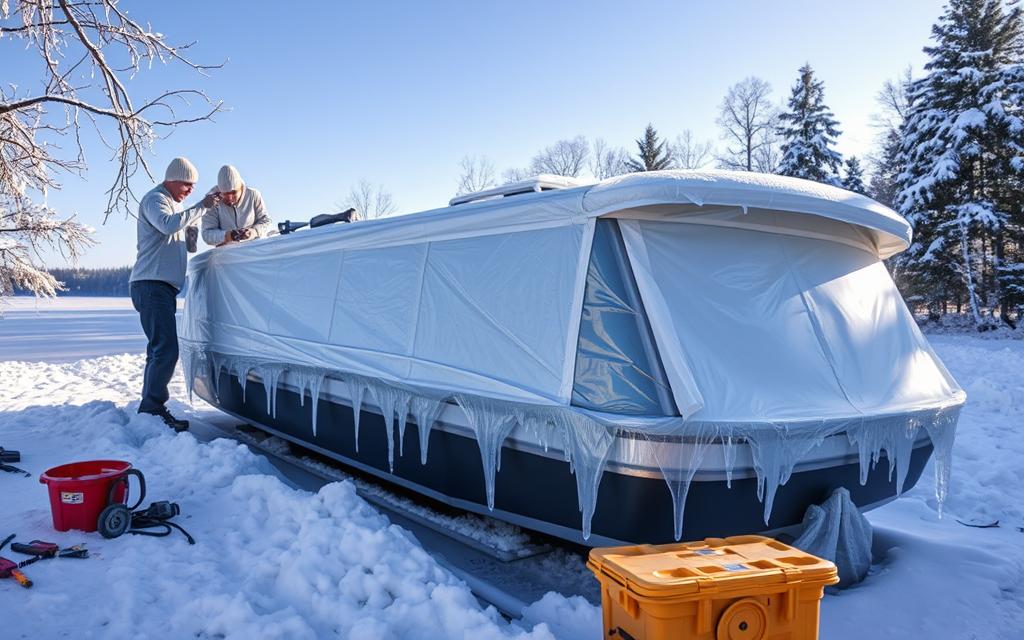Table of Contents

Keeping your houseboat safe during winter is key to its value and avoiding expensive fixes. As someone who loves boating, I know how important it is to store your houseboat right. Winterizing it needs careful planning and detail to keep it in great shape.
Storing a houseboat on land is more than just parking it. You need a full plan to avoid damage from freezing, moisture, and wear. Without the right steps, you could end up with big repair bills and structural issues.
This guide will show you how to winterize your houseboat fully. I’ll share tips and strategies to keep your investment safe. From inside to outside, I’ll give you expert advice for the toughest winter months.
Key Takeaways
- Comprehensive winterization prevents expensive damage
- Moisture control is critical for houseboat preservation
- Professional preparation saves money long-term
- Regular inspection prevents unexpected repair costs
- Proper storage extends your houseboat’s lifespan
Essential Pre-Storage Preparation for Your Houseboat
Getting your houseboat ready for winter storage needs careful planning. A professional service can protect your investment. I’ll show you how to keep your boat in great shape at any affordable storage facility.
Proper preparation is key to avoid expensive damage. It keeps your boat in top condition.
Interior Cleaning and Moisture Control
Start with a deep interior clean. Moisture is a big problem in winter, so:
- Remove all perishable items
- Clean all surfaces thoroughly
- Use moisture-absorbing products
- Ensure complete drying of interior spaces
“A clean and dry interior is the first line of defense against winter damage” – Marine Preservation Expert
Exterior Cleaning and Inspection
Exterior prep is just as important. I recommend a detailed clean and check for damage:
- Wash the entire hull carefully
- Inspect for any structural damages
- Apply protective coatings
- Check seals and possible leak points
Documentation and Insurance Check
Before storing, check your documents and insurance. Make sure your policy covers winter storage. Update any paperwork to protect your investment.
These steps will keep your houseboat in great shape all winter. It’ll be ready for your next adventure.
Winter Storage Tips for Houseboats: Complete Guide
Keeping your houseboat safe during winter needs careful planning. You must protect it from cold and moisture. This means taking care of many things.
Freeze protection is key. It stops damage from cold and wet. Create a plan that covers inside and outside your boat.
- Thoroughly clean all surfaces before storage
- Implement advanced shrink-wrapping techniques
- Use top-notch dehumidification methods
- Do detailed battery care
“Proper winterization is an investment in your houseboat’s long-term health and performance.”
Focus on these areas during storage:
| Storage Area | Key Preservation Techniques |
|---|---|
| Hull Protection | Apply protective marine wax, inspect for damage |
| Mechanical Systems | Drain water systems, use antifreeze, protect electricals |
| Interior Spaces | Remove moisture, use desiccant bags, ensure ventilation |
Professional preparation can save thousands in repair costs and extend your houseboat’s life. With these winter storage tips, your boat will stay in great shape.
Professional vs DIY Winterization: Making the Right Choice
Getting your houseboat ready for winter is a big deal. You have to choose between hiring a pro or doing it yourself. This choice can affect how well your boat is protected and how much you’ll spend on upkeep.
Cost Comparison Analysis
When it comes to winterizing your marine engine, cost is a big factor. Here’s a look at what you might pay for professional versus DIY services:
| Winterization Method | Estimated Cost | Complexity |
|---|---|---|
| Professional Service | $300 – $800 | Low personal effort |
| DIY Winterization | $100 – $250 | High personal involvement |
Time Investment Considerations
Preparing your boat for storage takes a lot of time. Pros can do it in 2-4 hours. But, if you’re new to this, it could take 6-10 hours or more.
- Professional service: Minimal time investment
- DIY approach: Requires full day of work
- Learning curve for first-time winterizers
Required Skills and Tools
“Proper marine winterizing requires technical knowledge and specialized equipment.”
For winterizing your houseboat, you’ll need:
- Marine antifreeze
- Fuel stabilizer
- Oil change kit
- Specialized marine maintenance tools
Think about your skills and how much time you have. DIY might save money, but pros can prevent expensive damage during storage.
Shrink-Wrapping Your Houseboat: Step-by-Step Process
Winterizing your houseboat is a must. Shrink-wrapping is a top choice for keeping it safe in the marina. I’ll show you how to do it right to protect your boat from the cold.

- Heavy-duty shrink wrap material
- Protective frame supports
- Heat gun
- Weatherproof tape
- Ventilation patches
For effective winterizing, focus on ventilation. Add air circulation patches to stop moisture from building up.
“Proper shrink-wrapping is your boat’s winter armor against harsh environmental conditions.”
Here’s how to shrink-wrap your boat:
- Clean the houseboat well
- Put up the support frame right
- Measure and cut the shrink wrap
- Wrap it carefully, avoiding wrinkles
- Seal it tight with a heat gun
- Add ventilation patches
| Shrink-Wrap Material | Recommended Thickness | Best Use |
|---|---|---|
| Marine-grade polyethylene | 9-12 mil | Heavy winter environments |
| Standard polyethylene | 6-9 mil | Moderate climate zones |
Professional tip: Always leave access points for periodic inspections during winter storage.
Engine and Mechanical Systems Protection
Winter storage needs careful attention to your houseboat’s engine and mechanical systems. This ensures your boat stays in great shape during the cold months. It also helps avoid expensive damage from freeze protection issues.
Proper engine preparation is key to protect your investment. It helps prevent mechanical failures.
Fuel System Winterization
Keeping the fuel system in check is vital for winter storage. Here’s what to do:
- Use a fuel stabilizer to prevent fuel degradation
- Fill the fuel tank to minimize condensation
- Run the engine with stabilized fuel to distribute treatment
Battery Maintenance Protocol
Battery care is important to avoid damage during storage. Follow these steps:
- Fully charge the battery before storage
- Disconnect and remove the battery
- Store in a cool, dry location
- Use a trickle charger to maintain charge
Engine Antifreeze Application
Preventing freeze damage is key for your houseboat’s mechanical health. Use marine-grade antifreeze by flushing the cooling system. Then, replace water with the antifreeze solution.
“Proper winterization is an investment in your houseboat’s longevity and performance.” – Marine Maintenance Experts
| Winterization Task | Recommended Action | Frequency |
|---|---|---|
| Fuel System | Add stabilizer | Before winter storage |
| Battery | Full charge, disconnect | Before storage |
| Engine Cooling | Flush with antifreeze | Annually |
Investing time in thorough engine preparation will save you significant expense and frustration when spring arrives.
Preventing Freeze Damage in Plumbing Systems
Winterizing houseboats is all about keeping plumbing systems safe. Freeze damage can lead to costly repairs if you don’t prepare properly. It’s key to know how to protect your boat’s water systems during cold months.
- Completely drain all water tanks and lines
- Use non-toxic marine antifreeze for vessel systems
- Disconnect and store water pumps in a dry place
- Seal all exterior plumbing connections
Dehumidification is also vital to prevent moisture damage. Too much water can lead to pipe corrosion and structural problems during storage.
“Proper winterization is your best defense against costly marine repairs” – Professional Marine Technician
Here are key steps for plumbing protection:
- Check all pipes for damage
- Flush systems with antifreeze solution
- Apply protective coatings to vulnerable parts
- Keep a record of your winterization steps
Spending time on plumbing prep will protect your houseboat from winter damage. This ensures a smooth start when spring comes.
Climate Control and Dehumidification Techniques
Keeping your houseboat safe during storage means managing the climate well. Moisture can harm your boat, so it’s key to control humidity. This helps keep your winter covers and boat in top shape.
Optimal Humidity Levels for Marine Storage Solutions
Getting the humidity right is vital for your boat’s winter care. The best humidity for houseboats is between 40-50%. Too much humidity can lead to:
- Mold growth
- Wood rot
- Metal corrosion
- Fabric deterioration
Ventilation Strategies
Good air flow stops moisture from building up. I suggest using both passive and active systems for winter storage.
| Ventilation Type | Benefits | Recommended Use |
|---|---|---|
| Passive Vents | Low-cost, minimal maintenance | Small to medium houseboats |
| Electric Fans | Active air circulation | Larger vessels, humid environments |
| Powered Ventilators | Maximum air exchange | Complex storage conditions |
Dehumidifier Selection Guide
Picking the right dehumidifier depends on your boat’s size and where you store it. Think about these things:
- Boat interior square footage
- Average local humidity
- Storage location climate
- Power source availability
“Proper climate control isn’t an expense—it’s an investment in your houseboat’s longevity.” – Marine Preservation Expert
Using these climate control methods will keep your houseboat in great shape all winter. It protects your boat from harm.
Choosing the Right Storage Location
Finding the perfect spot for winter storage is key to keeping your houseboat safe. The right spot can help keep your boat’s battery in good shape and avoid damage from freezing.

- Climate conditions in your area
- How secure it is
- If you can get there easily in winter
- The cost of the storage
- How close it is to places that can fix your boat
I’ve made a detailed guide to help you pick the best storage:
| Storage Type | Pros | Cons | Best For |
|---|---|---|---|
| In-Water Storage | Easy to get to, no moving needed | More chance of damage from freezing | Mild winter areas |
| Dry Dock Facility | Good protection, safe and secure | Costs more, needs moving | Areas with very cold winters |
| Indoor Storage | Best protection, controlled climate | Most expensive | For top care of your boat |
Planning ahead is key to keeping your houseboat safe in winter. Using a dehumidifier for your boat can also help. It keeps moisture levels down and prevents damage.
“The right storage location is your boat’s first line of defense against winter’s harsh conditions.” – Marine Preservation Expert
Remember to check local rules and zoning laws. They might affect where you can store your boat in winter.
Marina Storage vs Dry Dock Facilities: Pros and Cons
Choosing the right storage solution is key in the boat decommissioning process. It’s important to protect your marine vessel during the winter. You need to look at different storage options carefully.
Marina services and dry dock facilities each have their own benefits for keeping your boat safe during the off-season.
Security Considerations
- Marina Storage:
- 24/7 on-site staff monitoring
- Gated access with security checkpoints
- Frequent vessel check-ins
- Dry Dock Facilities:
- Secure fenced perimeters
- Advanced surveillance systems
- Limited human traffic
Accessibility Options
Choosing between marina and dry dock storage affects maintenance and off-season use. Marina locations are often easier to get to. This means you can check on your boat more often and even take weekend trips.
Cost-Benefit Analysis
| Storage Type | Average Cost | Key Benefits |
|---|---|---|
| Marina Storage | $50-$200/month | Convenient access, professional monitoring |
| Dry Dock Facilities | $30-$150/month | Lower cost, enhanced security |
“The right storage solution can save you thousands in damage and maintenance costs.” – Marine Storage Expert
Your specific needs will decide the best storage option for your vessel during winter.
Conclusion
Winter storage for houseboats needs careful planning and preparation. My detailed winterization checklist helps protect your valuable boat from cold weather. It’s not just about maintenance; it’s about keeping your investment safe and ready for spring.
By using strong de-winterization steps and protective plans, you can lower damage risks. The methods in this guide, from engine care to climate control, help keep your boat safe during winter. Storing your boat properly is a smart investment in its long-term health.
As you get ready for winter storage, every step is important. From shrink-wrapping to controlling moisture, your efforts now will affect your boat’s condition and readiness for future trips. Knowing and using good cold weather protection strategies can save you time, money, and avoid repair problems later.
When spring comes, your houseboat will be ready to hit the water with little downtime. By following this winterization plan, you’re not just storing a boat. You’re making sure you can enjoy your maritime lifestyle without interruption.
FAQ
How long can I safely store my houseboat during winter?
You can safely store your houseboat for 3-6 months in winter. This depends on where you live and the storage conditions. Look for professional facilities with climate control and regular checks to keep your boat in top shape.
What is the average cost of professional winterization for a houseboat?
Winterizing a houseboat costs between $500 and $2,500. The price varies based on your boat’s size, system complexity, and needs. Shrink-wrapping, engine care, and protecting systems all add to the cost. Get quotes from different services to find the best deal.
Can I winterize my houseboat myself, or should I hire a professional?
If you know a lot about boats, you might winterize it yourself. But, hiring a pro is safer. They have the skills and tools to protect your boat fully. If you’re unsure, a professional can save you from costly mistakes.
What are the most critical systems to protect during winter storage?
Protect your boat’s engine, plumbing, electrical systems, and hull. Stabilize the fuel system, drain water, protect batteries, and prevent moisture. Use antifreeze to avoid freeze damage.
How often should I check on my houseboat during winter storage?
Check your boat every 4-6 weeks in winter. Look for moisture, check shrink-wrapping, battery levels, and for damage. If you’re in a professional facility, they might inspect it for you.
What’s the best method for preventing moisture and mold during winter?
Use dehumidifiers, ensure good ventilation, and apply products like silica gel packets. Keep humidity between 40-50%. Consider using heating pads or climate control in your storage area.
Is shrink-wrapping necessary for winter houseboat storage?
Yes, shrink-wrapping is key, mainly in cold areas. It guards against snow, ice, UV, and pests. A pro’s wrap can last 4-6 months and is better than canvas.
How do I prepare my houseboat’s battery for winter storage?
Charge the battery fully, clean terminals, and apply anti-corrosion spray. Use a trickle charger or maintainer. Remove the battery if you can and store it in a cool, dry place. Charge it every 4-6 weeks to keep it healthy.
What insurance considerations are important during winter storage?
Check your marine insurance to see if it covers winter storage. Make sure it covers risks like freeze damage, theft, and environmental hazards. Some insurers offer lower rates for off-season storage, so talk to your provider about your plans.
How early should I start preparing my houseboat for winter storage?
Start getting ready 4-6 weeks before it gets cold. This time lets you clean, check systems, and book services. Early prep helps avoid last-minute stress and ensures your boat is well-protected.



